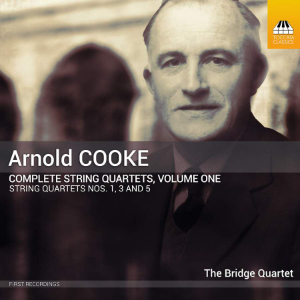
Arnold Cooke (1906-2005)
Complete String Quartets Volume 1
String Quartet No.3 (1967)
String Quartet No.5 (1978)
String Quartet No.1 (1933)
Bridge Quartet
rec. 2022, All Saints’ Church, Thornham, UK
Toccata Classics TOCC0696 [56]
Let me begin by repeating the brilliant summary in the final paragraph of Peter Marchbank’s liner notes: “Taken as a series, the five string quartets of Arnold Cooke form an important thread through the chamber music of Britain in the middle years of the twentieth century. The longest-surviving pupil of Hindemith in England, he admittedly used the language and mannerisms of his teacher – but with restraint and always with an ear for lyrical beauty.”
A good hermeneutic for the appreciation of Cooke’s music is to accept his debt to Paul Hindemith, his composition teacher. Musicologist Malcom MacDonald wrote that what Cooke “imbibed was a broad framework of technique and a sense of direction: a view of music as a living polyphonic entity and a feeling for individual instruments that goes back to the practice of J.S Bach”. Also of importance is the influence of Bartók. And then there are some nods to “an undeniable English lyricism” that does not depend on overt pastoralism. Finally, Cooke typically did not follow compositional systems such as serialism.
Arnold Cooke’s biographical details can be found here.
The twenty-two-minute String Quartet No. 1 was completed shortly after Cooke had returned from study in Berlin, just before he assumed the position of Professor of Harmony at the Royal Manchester College of Music. A contemporary critic noted in Yorkshire Post and Leeds Intelligencer that Hindemith’s influence was clear in “its lack of adipose tissue [body fat!], its studious avoidance of the purple patch, its astringent but apt writing for strings and for the quartet medium, and its strained tonality”. The Manchester Guardian suggested that listeners “wore the hairshirt of Mr. Cooke’s quartet”. Yet there is more to this work than acidity.
The opening fugue begins conventionally, but soon drifts off into a tonal no-man’s land. The Scherzo, placed second, is vibrant if severe. The slow movement, an Intermezzo, is often songlike if at times a little bitter. The finale is vibrant, with little to challenge the listener. Strangely, it ends on a common chord, thus negating much of its modernity.
According to Eric Wetherell’s monograph Arnold Cooke (British Music Society, 1996), the composer wrote the String Quartet No.3 “because he had always enjoyed playing quartets at Cambridge but had not tried his hand at this medium since 1948”. I think that Bartók is an influence more relevant here than Hindemith. The opening Allegro energico sports a “strong dotted rhythm” and is “strongly contrapuntal”. Equally Bartókian is the Scherzo with its driving dance-like theme. This is preceded by a lyrical Andante where Cooke charts his own individual course. The middle section disturbs the overall poise of the mood with its “martial interlude”. The finale, Allegro vivace, is characterised by a prominent “Scotch-snap” as well as a remarkable pizzicato passage. The movement concludes emphatically in the “home” key of G major.
Arnold Cooke’s fifth and last String Quartet, commissioned by the Ticehurst and District Music Club, Sussex, lasts for less than ten minutes. The track listing shows three movements, the liner notes suggest that it is “ostensibly in one movement, embracing all the elements of a traditional four-movement quartet”. The opening Moderato presents a short unison theme, the basis for the melodic material of the entire quartet. It is initially worked out in shortened sonata form. This slips into an energetic Scherzo, which also includes two “calmer and more lyrical” passages. The finale is powerful, combining a fugal opening, a dance-like romp, hints at earlier material. A brief but vigorous coda culminates in a terse pizzicato chord.
Peter Marchbank, the liner note writer, gives detailed information about all three quartets, including descriptive notes and reception history. The notes have been immensely helpful in the preparation of this review. There is a useful mini-biography of the composer and a résumé of the Bridge Quartet. (Toccata Classics have already released a CD of Arnold Cooke’s organ music, reviewed here.)
The performance is committed and enthusiastic. The Bridge Quartet has played these works at concert venues over the past few years, and are clearly powerful advocates of Cooke’s chamber music. The recording is ideal.
Let me observe that Hindemith is often credited with promoting Gebrauchsmusik (utility music). That effectively meant music with a social or didactic purpose, often deemed to be playable by amateurs – and not to be seen as “art for art’s sake”. Hindemith eventually disowned this term applied to his work. It certainly cannot be applied to Cooke’s music here, whether descriptively of pejoratively. Each Quartet is an accomplished piece of writing, technically involved and satisfying to all concerned. Even a cursory hearing will not detect any element that can be described as “improving” for either the performers or the audience.
It is fantastic that listeners can hear recordings of a fairly wide range of Arnold Cooke’s large catalogue, including symphonies, organ music and chamber works. (Presto Music lists a dozen monographic discs and three dozen others.) I look forward to assessing the second volume of String Quartets soon.
John France
Previous reviews: Hubert Culot (September 2023) ~ Jonathan Woolf (October 2023)
Help us financially by purchasing from





















